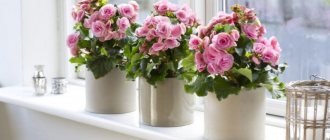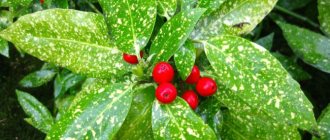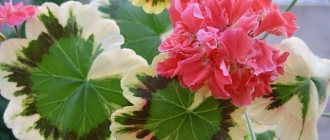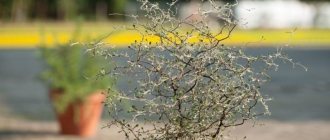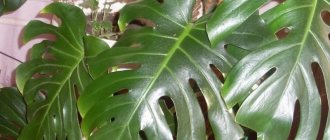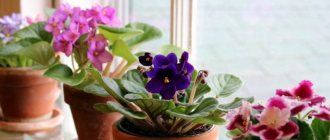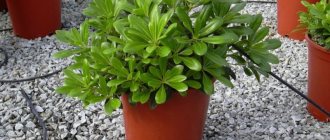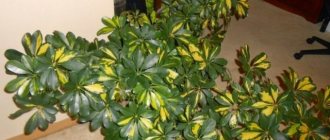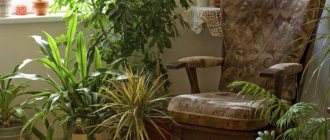Light-loving decorative foliage plants for the home
These plants are valued for the beauty of their leaves.
Depending on the species, their leaf blades attract attention with their unusual shape or color. All light-loving ornamental foliage plants must be kept in good light, otherwise their shoots will stretch and the leaves will lose their decorative color.
Let's take a closer look at light-loving decorative foliage indoor plants with their names and photos.
Alocasia
A tropical light-loving plant that requires high humidity and bright lighting. It has a thick rhizome and a modified short stem. Alocasia leaves are located on long petioles. The leaf blades are arrow-shaped, with pronounced light veins. The plant reaches a height of 60-70 cm.
Begonia decorative foliage
Deciduous types of begonias are distinguished by very bright and unusual leaves, as well as inconspicuous flowering. These are very unpretentious indoor plants that require bright light to grow properly.
Typically these are groundcover varieties that have a fairly short and branching stem. The leaves are petiolate, of various shapes and colors. With a lack of lighting, they can lose their color and stretch out.
Dracaena
Dracaena is an ornamental foliage, light-loving plant, shaped like a palm tree. Its leaves are narrow and long, pointed at the ends. They are concentrated mainly at the ends of straight and powerful shoots.
A plant grown indoors usually does not branch on its own; side shoots can be obtained by pruning the plant. Requires bright lighting, otherwise the shoots grow weak and thin, the leaves quickly dry out, and the trunk becomes bare.
Calathea
A very beautiful and light-loving indoor plant, shaped like a bush. Its trunk is greatly shortened, the leaves grow on long petioles. Calathea leaf blades have an oblong shape and a very unusual coloring. The surface of the leaf is covered with a complex variegated pattern of various shades of green. The leaves resemble bird feathers. Calathea is a capricious plant that only experienced gardeners can grow.
Croton
An evergreen shrub, very popular in indoor culture. It has a straight and branching trunk. The shoots are powerful and straight, covered with leathery leaves of bright color. The shape of croton leaves is unique.
It can be from solid to heavily dissected. The color of the leaves is also very diverse. They can be colored green, yellow, red, orange and burgundy.
When growing croton, special attention should be paid to lighting. Its deficiency inevitably leads to loss of color and decorative shape of the plant.
Monstera
Large indoor plant, powerful vine. Its thick shoots reach a length of 1.5 m or more. The leaves are very large and strongly dissected, up to 1 m in diameter. They are attached to the shoot on long petioles. Forms numerous aerial roots for support. With insufficient lighting, monstera shoots stretch, and the leaves lose their dissection and become whole.
Syngonium
Syngonium is a perennial vine widely used for indoor landscaping. Its shoots can reach several meters in length. It is also possible to give the syngonium a bush form. The leaves of the plant are arrow-shaped or heart-shaped. They reach a length of 20 cm. There are many varieties of this species with leaves of a wide variety of colors: white, light green, bright green, pink, reddish.
Plants that tolerate shade as long as there is backlighting
Aglaonema. This inhabitant of window sills is related by blood to Dieffenbachia. For this reason, these plants are very similar. Aglaonema has narrower leaves and a smaller size. Needs additional lighting in winter.
Anthurium. This is a well-known fashionista with waxy flowers that vaguely resemble calla lilies. Due to lack of lighting, the plant's leaves become smaller and the inflorescences lose their color.
Begonia. It is unlikely that any plant can compare with the color palette and luxury of begonia patterns. Some consider the decorated beauties too prim and aggressive, while others are ready to endlessly enjoy their grace. Be that as it may, the plant leaves no one indifferent. When choosing a place for deciduous begonias, you must be guided by their individual needs. The following varieties require year-round shading: Diadem, grape-leaved, Schmidt, Richardson, etc.
Dieffenbachia. A shade-loving plant with wide leaves decorated with a variety of patterns, it has become a must-have in almost every home and office. And the secret of his popularity lies, first of all, in his flexible disposition. The indoor dweller quickly forgives mistakes in care and puts up with the lack of light.
Ctenanta. The main advantage of this plant is its very beautiful and varied leaves. On the even background of the leaf, stripes, oval or triangular spots stand out, which disappear in too bright or dark places.
Green ivy. Although these are shade-tolerant plants, they require a bright place in winter.
Flowering shade-loving plants
Popular unpretentious indoor flowers that bloom all year round
In the shade, some indoor plants not only become covered with lush green foliage, but also bloom beautifully. Therefore, the northern windows can be decorated with flowering vegetation.
Spathiphyllum
It gained popularity because of its second romantic name - “women's happiness.” What attracts many lovers of home greenhouses is its lush dark green foliage and many white flowers, similar to small calla lilies or sails. Spathiphyllum is sensitive to watering; it should be moderate, preferably in a tray. The leaves need to be sprayed periodically, and once a month the flower needs a shower. “Women's Happiness” is well suited as a nice gift for a woman, for example, on a birthday or on March 8th.
Saintpaulia
A variety of violet, fleshy, slightly fuzzy, dark green leaves and many delicate lilac flowers. Feels good on northern windows. It is better to water with settled water at room temperature in the pan. Doesn't like overflow. They bloom for a long time, faded rosettes are immediately replaced with new ones. Amateurs are constantly developing new varieties with a wide variety of flower shapes. In many cities, enthusiasts and lovers often organize exhibitions and sales of dozens of varieties of violets, including Saintpaulia.
Begonia
Another shade-loving houseplant with beautiful bright flowers, familiar and loved by many. Quite unpretentious, it needs moderate watering. Does not require spraying leaves. Sensitive to air humidity. It has decorative flowers and leaves. It blooms both in winter and summer. About 2000 varieties of begonia have been bred in the world.
Miltonia
The flowers of this representative of orchids resemble surprised, wide-open eyes. Hence the second name - “pansies”. It grows well in the shade, does not tolerate drafts, and loves good watering. The fact that the plant is comfortable is indicated by the pinkish color of the leaves and abundant flowering.
Strepcocarpus
Just a godsend for beginning gardeners. Unpretentious, blooms for almost six months. Does not require special care other than watering. Any part of streptocarpus is suitable for reproduction. Shade-loving, flowers are large, in the form of bright bells.
Vriesia
This beauty with a bright large flower in the form of a spike, despite its capriciousness and demanding self-care, is known and appreciated by many flower growers. It blooms for a long time, requires watering with warm water, very abundant in summer, spraying the leaves and wiping them with a sponge. There are about 250 species. Loves moist air and does not tolerate drafts. Prefers partial shade.
How to properly care for light-loving flowers?
Many of those who plan to buy indoor plants rarely think about their lighting needs. Basic flower care is limited to watering, periodic feeding and spraying of leaves on particularly hot days. But it is worth knowing that there are light-loving sprouts, and there are those that calmly tolerate shade or even shade-loving ones for which bright light is destructive. And before you decorate your home with potted flowers, you should know which of them grow well in the light. This will help prevent the plant from dying.
What types of light-loving plants are there?
Light-loving plants: description of sun-loving flowers that love direct sunlight
An example of heliophytes can be cited from any type of plant, be it trees, bushes, grasses, or representatives of flora growing in water. Let's look at what heliophytes are found in our latitudes.
- Trees. These include: birch, linden, pine (common, mountain), ash, apple, white mulberry, juniper, oak (common, English), quince, aspen, etc.
- Shrubs. These include lilac, rose, sour thorn, jasmine, some types of hydrangea, etc.
- Herbal and cereals. These are tomato, water lily, plantain, corn, lingonberry, heather, etc.
Those who like to grow flowers at home need to take into account data on the light sensitivity of the flower that will grow in a pot on the windowsill. Before purchasing a certain plant, it is worth knowing all its characteristics so that it can live in your apartment without any problems. Returning to the current topic, we can give several examples of light-loving indoor plants.
- In many homes you can find a flower such as begonia. It is a light-loving plant, but it is still better not to place it under direct scorching rays from May to September.
- Kalanchoe also loves light, but not direct rays, which can cause burns on the leaves.
- Monsteras, sansevierias and dracaenas will do well under bright, diffused rays or in partial shade.
- Phalaenopsis is a type of orchid that loves light, but not heat, so it is good to place them on an eastern window.
- Fuchsias are not averse to bathing in the sun in the morning or in the afternoon.
- Cyclamen also benefit from bright lighting, but it is advisable to place them in direct rays only in winter. The same conditions need to be created for violets. As daylight hours decrease, you can move them slightly closer to the window from a distance of about 2-3 meters during the hottest period.
Saintpaulia or Usambara violet (Saintpaulia)
This plant grows wild on the coasts of water bodies in East Africa. Saintpaulia gained wide popularity in Europe and America only in the 20th century, shortly after its discovery and description in 1892. To date, over 32 thousand varieties of Uzambara violet have been bred. The leaves of the plant are densely covered with small fibers, the flowers are simple or double, multi-colored. When caring for Saintpaulia, you should avoid getting water on the leaf blades to avoid burns from the sun's rays.
Saintpaulia prefers to grow on eastern and western windows in soft, diffused light. The pot is selected taking into account the size of the root system, but it is quite tight. In a spacious container, the roots will have to spend a lot of effort developing the soil and this will significantly delay the start of flowering. It is better to water Saintpaulia through a tray, since waterlogging of the soil can lead to rotting of the roots and death of the bush. Usually the flower is propagated by rooting the leaf, much less often by dividing the bush and by seeds.
Shade-loving flowering indoor plants with names
Medicinal indoor plants, home medicinal plants
Indoor flowers that are shade-loving include sciophytes, another name for which sounds like heliophobes. These plants do not tolerate direct sunlight, and can only develop in partial shade: only in this case will their foliage be decorative and their flowering abundant and bright.
Anthurium
There are also exotics that respond negatively to sunlight. When choosing a place for them, it is recommended to give preference to window sills on the north or west side of the house, shaded corners.
It is worth mentioning separately about indoor plants that do not bloom, but have decorative foliage of various shapes and colors. They lose their attractiveness if they are exposed to direct rays of light.
Anthurium
The culture is quite unpretentious: the plant thrives in partial shade, it requires a temperature of about +15 °C, regular but not excessive watering and maintaining air humidity, and applying fertilizers.
Anthurium looks especially attractive from April to September: at this time its inflorescences are covered with a dense waxy coating
At the same time, it is extremely important to ensure that sunlight does not fall on the leaf plates of the plant - this can cause burns.
Interesting! You can hear this plant called male happiness: it is generally believed that anthurium can have a beneficial effect on male strength.
Clivia
It differs from other shade-loving plants in its bright and showy inflorescences. In spring, bell-shaped buds open, the color of which can be yellow, orange or deep red.
Clivia
The flowering of clivia is determined by how the plant endured the dormant period in winter. During the cold season, it should be moved to a cool place, the temperature should not be higher than +12 degrees. You also need to reduce the volume and frequency of watering, and stop adding nutrients. In winter, you should not replant or move the flower.
Vriesia
This bright representative of the Bromeliad family is characterized by the presence of a tall, up to 70 centimeters, inflorescence crowned with bracts. Lush flowering of a shade-tolerant indoor plant is possible only if a consistently warm temperature is maintained - from +18 to +26 degrees, as well as regular soil moistening and a high level of air humidity.
Important! When watering, you need to pour water inside the leaf rosette. It should be changed at least once every three days
In this case, old water must be removed using paper napkins, only after that fresh water must be poured.
Saintpaulia or Uzambara violet
Experts say Saintpaulia is the most common flowering plant. In order for the violet to grow and develop normally in partial shade, a number of other factors will have to be taken into account. These include, for example, high air humidity and temperatures from +20 to +25 °C.
In the wild, the flower is found in Tanzania. It was discovered by Baron Walter von Saint-Paul (which is why the plant got its name). Depending on the variety, the flowers of the Uzambara violet can have very different shapes: there are stars, bells, and wasps. The doubleness also depends on the variety: violets can be semi-double, double or non-double.
Usambara violet
The diameter of the opened flower can be from 6 to 40 centimeters. It all depends on whether the outlet is miniature, semi-miniature or standard size.
Features of care
Light-loving shoots, as the name implies, are those that need a lot of sun for normal development. If shade-loving flowers grow calmly in such extreme conditions as partial shade and coolness, then these flowers may begin to get sick or even die if there is not enough sun. You just need to protect the leaves from direct rays to prevent burns from forming on them. The ideal option is a large, bright room with windows facing south, southwest or southeast, where plants can be placed not next to the window, but still receive the required amount of light.
But this is not the only condition that such pets require for their life. In most cases, these are tropical, subtropical desert inhabitants: ficus, hibiscus, gardenia, Kalanchoe, oleander, agave and others. Consequently, such flowers also need other mandatory conditions for normal growth, often very different from those that shade-loving or even shade-tolerant sprouts prefer.
The soil
Light-loving flowers, for the most part, love fertile soil. You can either purchase suitable soil in the store, or make a mixture of peat soil and turf. For ficus and succulents it is worth adding sand. And be sure to first pour a layer of drainage into the pot, and only then add soil. This will help prevent stagnation of water in the roots and, as a result, rotting of the plant.
Temperature
Sun-loving flowers, in addition to a lot of sun, are heat lovers. It is advisable that the air temperature in the room be kept within +24-+26 degrees. Some plants, for example ficus, are able to live at temperatures below +20. But most often, under such conditions, shoot growth gradually slows down. These shade-loving pets live quietly in the cool, and sun lovers begin to get sick. If this happens and the flower begins to shed its leaves, then it is worth finding a warmer place for the green pet. They also do not like drafts, as well as currents of hot air. Therefore, it is worth keeping light-loving sprouts away from radiators and from places where there may be cold air.
Humidity
If shade-loving pets can go without water for a long time, then these flowers need sufficient watering. The water should be soft and warm. Light-loving flowers should be watered at least twice a week in summer - as the soil dries out. In winter, the amount of water should be reduced to once a week. In some cases, watering once every two weeks will be sufficient if the soil does not dry out completely.
As for spraying, these indoor green pets, for the most part, are lovers of moist air. Therefore, it is worth periodically spraying them with water from a spray bottle. Especially on summer days, when the air becomes very dry and the leaves of flowers may begin to dry out and fall off. In addition, it will not be a bad idea to occasionally bathe houseplants in the shower, or you can place pots in trays with wet gravel. These simple methods will help keep the air quite comfortable.
Top dressing
Any indoor flowers, including those who love a lot of light, need fertilizer periodically. Additional feeding should not be carried out constantly, but only from spring to autumn. It is during this period that flowers are actively growing, and the minerals contained in the soil are not enough for them. In addition, fertilizing should be carried out after replanting plants and after pruning.
What problems might you encounter?
Experienced flower growers know well what light-loving plants like, and based on this, they create the necessary conditions. Beginners who love indoor plants achieve everything through trial and error, which can often lead to negative consequences. Therefore, you should carefully monitor your green pets in order to take the necessary measures in time. The main trouble is, of course, not enough sun.
Signs of lack of lighting are:
- new shoots become thin and weak;
- the plant stops growing;
- the lower leaves dry out, turn yellow, and begin to fall off;
- the flower stem becomes thin;
- on flowering plants, new buds rarely appear and immediately fall off;
- the color of the leaves becomes paler, the variegated ones change color to green.
In case of such manifestations, the first thing to do is to move the flower pot to a brighter room or closer to the window. If this is not possible, you should turn on a fluorescent lamp or a special phytolamp next to the green pet. Such devices can compensate for the lack of sunlight in winter or in those houses where the windows face north. Perhaps in just a few days the plant will become brighter, stronger and produce new shoots.
In addition, novice flower growers are faced with a lack of moisture and heat in their wards. While shade-loving plants can easily tolerate low temperatures, sun lovers may die in such conditions. If indoor flowers have stopped growing, the leaves began to dry out or turn yellow and fall off, the variegated color has become faded or even changed to green, then perhaps the plants do not have enough moisture or the room is too cold. The solution is simple - change the watering mode and move the pot to another room. But you should be especially careful with water. Watering too frequently can lead to rotting of the roots and subsequent death of the plant.
Those who decide to grow a light-loving flower will have to try to create suitable conditions. But with the right approach and proper care, it is not as difficult as it might seem.
You may also find the following materials useful:
- How to quickly and correctly grow petunia seedlings
- How to make drainage for flowers with your own hands?
- Growing viola from seeds: recommendations from experienced gardeners
- Marigolds planting and care
- Growing pansies from seeds
Indoor light-loving plants with names and photos
The abundant flowering of many plants directly depends on how much sunlight they receive. It should be borne in mind that not all light-loving crops are absolutely light-tolerant - some of them are afraid of direct sunlight. Therefore, they need to provide diffused light.
Begonia
The family includes about a thousand species. They differ both in appearance and in content requirements. Large representatives of the family can reach a height of 3 m, while low-growing species do not exceed 20 cm.
Begonia includes about a thousand varieties
Geranium
This is one of the most common examples of a light-loving plant. Geraniums can be found naturally in South Africa. This is what determines the culture’s requirements for living conditions: long daylight hours and fairly high air temperatures. Geranium is famous for its lush flowering, which can be white, pink, or scarlet.
Geranium is conventionally divided into two categories: fragrant and flowering. The first category is characterized by rather unremarkable inflorescences, but the bright aroma of the leaves. The second category, on the contrary, is famous for its beautiful and long-lasting flowering.
Geranium is famous for its lush flowering
Kalanchoe
The culture belongs to the Crassulaceae family and is characterized by a love of sunlight. Kalanchoe is native to Asia, America, and Australia. The culture needs long daylight hours (at least 12 hours).
Coleus
This plant is very popular among gardeners, as it is very beautiful and at the same time undemanding to growing conditions. Coleus foliage resembles nettles and combines various shades: burgundy, yellow, red, green.
Pedilanthus
This crop belongs to the Euphorbia family and grows in America. Pedilanthus loves long daylight hours, and the light must be diffused. Pedilanthus is characterized by an unusual foliage color: it combines white and light green colors.
Phalaenopsis
The orchid is an incredibly beautiful flower that grows naturally in Asia and Australia. Phalaenopsis is actively used in home floriculture and includes more than 70 species. Among phalaenopsis there are plants with different lighting requirements: some love the rays of the sun, others prefer diffused light or grow well in the shade.
Those that are characterized by light-loving need a 12-hour day of light. In any case, the leaves of the plant should be protected from direct sunlight, which can cause burns.
Ficus
Ficus is a light-loving crop, but can suffer from direct rays of the sun. To prevent this from happening, you should protect the leaves from ultraviolet radiation until the sun is especially active.
In winter, when there is a lack of lighting, it is important to provide the ficus with additional artificial light, otherwise the leaves may dry out and crumble.
Ficus indoors - light-loving culture
Cyperus
Cyperus is a perennial plant with herbaceous shoots. The leaves grow from nodes, making them resemble umbrellas. Cyperus grows well both in a shaded place and in conditions of bright but diffuse sunlight.
If cyperus is grown under artificial lighting, the daylight hours should be at least 15 hours. Author's advice
Cyperus is a perennial plant
Description of species
The beautiful appearance and abundant flowering of some plants directly depend on the amount of sunlight they receive. But not all sun-loving flowers can tolerate direct bright sunlight; some prefer diffused light.
Begonia
A plant whose family includes several hundred varieties. Each type has its own external distinctive characteristics, as well as individual characteristics and maintenance needs. Large species of the family can grow up to 2-3 meters in height, the smallest dwarf varieties do not exceed 20 cm. The flower loves diffused light and does not particularly favor direct sunlight.
The plant grows well not only in pots, but also in open ground , where it has more space for the root system. Caring for a begonia is to ensure that it absorbs scattered sunlight in a dosed manner; there is no need to keep it in direct rays around the clock. Loves regular, abundant watering, loose fluffy soil, fresh air, but without drafts.
Geranium
It loves light very much, ideal for southern windows; on very sunny days it needs to be slightly shaded so that the beautiful velvety leaves do not get burned. Geranium was born in South Africa, so it tolerates any bright light, feeling quite comfortable. The flower loves open ground and grows well until autumn, after which it should be dug up and placed in a pot to be kept on the windowsill. It prefers moderate watering and does not tolerate waterlogging of the soil , so you need to lay out a drainage system at the bottom of the pot. For abundant flowering, it requires nutritious soil and regular fertilizing.
The flower cannot be sprayed with water, since the upper surface of the leaves is pubescent and water can collect on the hairs, which can negatively affect their appearance.
A beautiful ornamental medicinal plant, loves bright light, easily tolerates direct sunlight, ideal for an apartment with windows facing south. Feels great in open ground, loves regular watering, loose soil, mineral fertilizers, and moist air. This plant loves to be sprayed with water, it is very prolific, small children grow on the cloves of each leaf, which, once in the ground, take root on their own and begin to grow quickly.
Coleus
This spectacular decorative flower has carved elongated leaves of incredible beauty, the variegated colors of which contain ideal combinations of green, pink, red and yellow. The surface of each leaf is covered with small fibers. The plant is easy to care for, the main thing is to provide it with warmth and sufficient light. Without intense lighting, the leaves of the plant begin to fade, and the bright variegated coloring disappears.
The plant can be classified as a crop that loves sun and heat. For comfortable life, coleus needs a warm room, constant air humidification and spraying with water at room temperature. Does not tolerate dry air and dry soil well.
The plant is perfect for the flowerbed of a private home; compositions of coleus of different colors look impressive and noble.
Pedilanthus
Belongs to the Molochaev family, originally from Latin America. In open ground it turns into a beautiful spreading shrub, has beautiful oval leaves of white and light green colors. Home conditions for keeping such a plant include a constant source of lighting without direct sunlight, placing it in the east or west of the apartment, moderate watering, regular pruning to form a decorative shape of the bush, and periodic feeding.
In spring and summer it likes to be kept warm, and cool in winter. Needs a constant supply of fresh air. The room where this flower is located needs to be ventilated more often.
Phalaenopsis
This is an orchid, an incredibly beautiful and exotic plant. Includes about 70 species, growing in the wild in Australia and Asia. Each type of phalaenopsis has its own requirements for lighting and watering. Some species are not afraid of the bright sun, others prefer shaded places for a comfortable existence. Light-loving orchids need long daylight hours, good watering, and moist air . It is demanding on the composition of the soil and does not tolerate frequent replanting.
It takes several months for an orchid to take root in a new place . In winter, daylight hours need to be artificially lengthened using additional lamp lighting. In the period between flowering it loves warmth, during flowering it prefers coolness.
Ficus
A beautiful light-loving plant, native to hot countries, the variety of species and varieties distinguishes this crop from others similar to it. Ficus can take the form of a tree, bush or vine. Depending on the species, the leaves of the plant can be plain or variegated, large oval or small narrow. Loves the sun, but does not tolerate direct sunlight, good regular watering, spraying with water at room temperature.
The beautiful leathery leaves of the plant must be wiped once a week with a damp cloth to remove accumulated dust. Needs warmth, does not tolerate drafts and cold. In winter, due to lack of sunlight, the plant needs additional artificial lighting. The lack of light negatively affects the life of the crop; its beautiful leaves fade, dry out and fall off.
Cyperus
A perennial ornamental plant, native to Madagascar, in the wild it grows along rivers and reservoirs, forming dense thickets. It has a spectacular appearance, thin long stems are crowned with narrow leaves that grow from nodules and are very similar to an open umbrella. Loves sunlight and damp places. Consuming moisture, cyperus evaporates it into the air, thereby moistening it, which has a beneficial effect on the development and growth of other plants located next to it.
It prefers placement on southern or western windowsills; it is better to slightly shade the plant from direct sunlight. Loves abundant watering, stable thermal conditions of at least 20 degrees Celsius in summer, needs coolness in winter . Loves fresh air and regular air humidification.
Physiology and morphology of light-loving plants
Light-loving plants have adapted to sunlight due to their physiology and morphology. They have thickened leaves that are located almost vertical to the sky and change position according to the height of the sun. Basically, their size is small, the shape can be dissected. The surface can be shiny or fluffy.
Heliophytes have superbly formed mechanical tissues with many veins and a huge number of stomata. Their representatives are fruit and ornamental trees and shrubs, luxurious herbs and charming flowers.
Among them are well-known trees:
- pine;
- acacia;
- birch.
Shrubs also like to bask in the sun:
- hawthorn;
- rose hip;
- barberry.
Herbaceous plants reaching for the sun:
- plantain;
- linen;
- St. John's wort.
Flowers love rays of light:
- peonies;
- roses;
- marigold;
- petunia.
Cyperus
Coming from sunny Madagascar, green cyperus also prefers sunlight and in nature grows in damp places, along river banks, forming entire thickets, almost like our reeds.
This plant loves moisture and sunlight, and at the same time evaporates this moisture, which has a beneficial effect on the plants standing next to it. At the same time, Cyperus is able to give any room a tropical look with its palm-like leaves.
Caring for Cyperus is not difficult:
- choose southern and western windows for them, this flower tolerates sunlight well and needs light shading only on the hottest summer days;
- Cyperus needs very abundant watering, do not be afraid to flood the flower, moisture will only benefit it. It is best to simply place the pot in a pan of water and provide your plant with so-called “bottom watering” - this is the best option for moistening the cyperus;
- Cyperus loves warmth; ideally, the temperature in the room where it grows should not fall below 20 degrees. In winter, you can keep it in a slightly cooler room, although this tropical plant does not have a dormant period, it is decorative all year round;
- the flower loves fresh air very much, so the room in which it is kept must be ventilated as often as possible;
- the plant must be renewed by pruning as the stems dry out and die.
If you provide the plant with everything it needs, it will delight you with its decorative tropical appearance all year round. At the same time, there are many varieties of Cyperus, there are even variegated forms.
Shade-loving indoor plants for the hallway
An ideal option for a hallway where there is no direct sunlight is decorative foliage plants. Usually they either do not bloom at all or have small and unattractive buds. But their foliage is bright and original.
Sansevieria
Flower growers call this plant pike tail, snake skin. Another name is mother-in-law's tongue. Sansevieria differs from other plants in its strict lines. It should be noted that in terms of its shade tolerance and undemanding conditions, this indoor pet can be compared with chlorophytum. At the same time, the plant is equally comfortable both in bright daylight and in the shade.
Sansevieria looks very impressive: when flowering, it produces candle inflorescences in white and yellow shades. There are specimens with original patterns on the leaf blades, but in deep shade they may fade.
Sansevieria
Ferns
An excellent option for the hallway is ferns. Their variety allows you to choose the ideal option for both office space and home. Even though ferns do not bloom, they bring a feeling of freshness and coziness to the space. At the same time, ferns grow well even in a shady location. The main thing is that the soil and air are sufficiently moist.
Crassula
Also called the money tree, this plant cannot fully develop in deep shade - it is comfortable only in low light conditions. Like other succulents, it likes diffused daylight, infrequent and moderate watering.
Important! Experienced flower growers recommend placing the fat plant on the windows on the east side of the house, and moving it to a shady corner in the summer. Otherwise, the leaves of the plant may get sunburned.
Ficus
This indoor plant is quite delicate, and therefore it is strictly forbidden to place it directly under the sun's rays. Ficuses are able to purify the air in a room, filling it with oxygen.
The plant likes well-ventilated rooms where there is no draft. The optimal temperature in summer is no more than 25-30 °C; in winter this figure can be about 15-20 °C. It is advisable to water the plant not only with settled, but also with heated water. In this case, watering should be moderate: too much moisture can destroy the crop.
Ficus benjamina
Additional Information! Ficus is a non-poisonous plant; moreover, it is capable of disinfecting the air, destroying bacteria and microbes.
This shade-loving indoor flower can be placed in the bedroom. In folk medicine, ficus is used as a remedy for various female pathologies and helps to quickly get rid of bronchitis.
Esotericists call ficus one of the most useful plants for the home. It is believed that it is able to protect the family from quarrels and conflicts; this is a real family amulet that helps build relationships between household members.
Schefflera
Sheflera is a lush branched bush with flexible graceful shoots. It feels comfortable in the shade, but you can place it in the sun for several hours a day. In this case, the pattern on the fleshy leaves will be more pronounced. If desired, you can enhance the branching of the sheflera; to do this, you need to pinch the tips of the branches.
Additional Information! Breeders have bred both compact and fairly large types of cheflera, and therefore every gardener can find a suitable one.
Caring for this shade-loving house flower is quite simple: you need to spray the foliage from time to time and maintain the temperature at +12 to +20 °C.
Schefflera
what fruit trees can be planted at the dacha?
Fetochka
Anemones and primroses have proven themselves well. You can plant astilbe, bergenia, periwinkle, lily of the valley, aquilegia, dicentra, yellow chamomile (doronicum), forget-me-nots, aruncus (volzhanka). All early spring bulbs are well suited for planting in the shade. Snowdrops (galanthus, scylla, muscari are often planted in the trunks of fruit trees, under bushes. Their flowering time is early spring, when the trees are still without leaves. At this time they have enough light, and the growing season of these plants is short. All herbaceous plants that are suitable for a shaded garden can be divided into two categories:Whether the soil is wet or dryShady areas of the garden are traditionally considered unsuitable for creating flower beds, and you cannot grow a beautiful green lawn here either.But this is not true at all!There are many shade-tolerant plants , quite suitable for landscaping the shady area of the garden. Of course, any vegetable still needs sunlight, but even if it only hits the area for a while or penetrates through the foliage, for some types of vegetables this will be quite enough. Great Almost all greens grow in the shade: lettuce, spinach, sorrel, horseradish, rhubarb, parsley, dill, cilantro, celery and mint.Onions grow well in the shade, including leeks and garlic. Regular watering and sunlight for 4-5 hours a day are enough for these plants. Beans, upright beans and peas love shade. Root vegetables - radishes, radishes, beets and carrots - feel great in shaded areas under fruit trees, as well as the entire cruciferous family: cabbage, Chinese cabbage, cauliflower and broccoli. Provide these vegetables with regular weeding and plant them in rows in an east-west direction so that they receive the maximum amount of indirect sunlight even in the shade. In the southern regions, some varieties, usually sun-loving: zucchini, cucumbers and tomatoes, grow well in partial shade. Lack of sun can only slightly delay the ripening time, but will not affect their taste and size in any way.
Lenochka
Verochka, you, excuse me, are a horse! ! What area? what kind of soil? Is there moisture in the ground? ! What exactly do you want? ! You can have viburnum, or you can have dates! ! :(((((((((((((
Boris Stepanov
Cherries should be planted on a hill and in a well-lit place, 2-3 m apart. It is best to do this in April, before the buds open. Cherries take root best when planted immediately after the snow melts, in the shortest possible time.
Natalia_56
Fill the areas of your garden where the sun rarely shines with shade-tolerant plants, and enjoy the beauty and diversity of nature in all its manifestations.
Lyudmila Aksarina
If the sun peeks into some corner of the garden for at least an hour, especially if it happens during the day, you can safely plant irises, daylilies, phlox, aconite, and peonies.
Daniil Slepnev
Daffodils and tulips can also grow in shaded areas, but they are more light-loving, so they use some tricks for growing bulbs. Whiteflower and ornithogallum (poultry plant) feel good in the shade; you can grow crocosmia.
.She is the most.
Shade-loving. These plants prefer shady areas; they grow worse in bright sun than in the shade (hosta, lily of the valley, periwinkle).
Alexeyevich
The shade of a particular area of the garden is determined by the duration and intensity of sunlight it receives. If the area is illuminated by the sun 1-2 hours a day, then the light is not enough for most flowers, especially if the sun comes here early in the morning or at sunset. Some places may not receive direct sunlight at all, receiving only diffuse light. Usually these are areas near the walls of buildings on the north side.
Tatyana Vasilievna
In any garden there are places where the sun rarely shines. Shaded areas under trees and areas near the north side of buildings are considered problem areas. For ordinary garden flowers and ornamental shrubs, there is not enough light here for normal development. But with some experience, you can always choose plants that will feel very comfortable here.
Filipich
What plants love shade? To create a decoration path, you will need to purchase sand, plastic film, drying oil and the pine stumps themselves. Heat the drying oil to a boil, and then apply it over the entire surface of the wooden circles. Wait until everything is dry and start preparing the area for the path.
Adaptation of heliophytes to unfavorable conditions
The environment is not always kind to light-loving plants. An example of how a cherry tree disappears and does not bear fruit if it is in the shade will be familiar to many people who are at least a little involved in gardening. But first, the plant will do everything it can to get more light. This is mainly expressed in the increased surface area of the sheets and a deeper green tint, because it is known that dark colors absorb more energy from the sun's rays. Also, for the same purpose, the stems of plants are stretched, but at the same time they become more fragile, and the trees grow taller or can change their shape in order to receive more light.
And a little about the author’s secrets
Scots pine watereri: varietal characteristics of the plant
Have you ever experienced unbearable joint pain? And you know firsthand what it is:
- inability to move easily and comfortably;
- discomfort when going up and down stairs;
- unpleasant crunching, clicking not of your own accord;
- pain during or after exercise;
- inflammation in the joints and swelling;
- causeless and sometimes unbearable aching pain in the joints.
Now answer the question: are you satisfied with this? Can such pain be tolerated? How much money have you already “wasted” on ineffective treatment? That's right - it's time to end this! Do you agree? That is why we decided to publish an exclusive interview with Oleg Gazmanov, in which he revealed the secrets of getting rid of joint pain, arthritis and arthrosis.
Let's test your knowledge
Key questions
1.
What ecological groups of plants in relation to the light regime do you know?
2. Name the characteristic adaptations of sciophytes. 3.
To which ecological group do the plants listed below belong: lungwort, cuckoo flax, wood sorrel, bracken, male shield?
4.
From the proposed list of plants, select representatives of heliophytes: sphagnum, coltsfoot, plantain, wheat, male shield, sunflower, sedum.
Difficult questions
1.
1 kg of fresh leaves of different plants contains different amounts of chlorophyll: for example, plantain has 1.8 g, and quinoa has 3.8 g. Explain the reason for these differences.
2.
Why do you think the small clearing contains some plant species that are different from those found in the surrounding forest?
3.
Establish a correspondence between the names of ecological groups of plants and their representatives. Ecological groups of plants: 1 - sciophytes; 2 - facultative heliophytes. Representatives: a) cuckoo flax; b) whine; c) plantain; d) sorrel; e) touchy; f) hazel; g) blackberries; h) lilac.
Individual homework.
Compare two plants of different ecological groups growing in different light conditions (for example, in a forest and in a meadow or in a dense park and in a flower bed). Find structural features in them that are an adaptation to different degrees of illumination.
Decorative foliage
Aucuba
The most inept gardeners are always advised to grow cotoneaster on their plot. Aucuba is the closest relative of cotoneaster, and therefore is a salvation for indoor floriculture.
A shade-loving and shade-tolerant flower with small variegated leaves is physically able to grow where no other plant can survive. Therefore, it can be safely placed in an unlit hallway or the far corner of the bedroom.
Sansevieria
This potted palisade can withstand truly Spartan conditions, which is why it has been grown in office centers since the times of the USSR.
There are many subspecies, but the most common is with long protruding flat leaves, with a yellow border along the edge. There is also small-leaved sansa, ideal for small spaces. Round-leaved plants are often woven into braids - it looks very decorative.
Aglaonema
Even without sunlight, this plant will not lose its bright color. It cannot be called 100% shade-loving, but rather suitable for any conditions, from shade to bright sun. The only thing it doesn’t like is drafts, so take care to protect your plant from blowing.
Advice! Aglaonema perfectly absorbs various toxins, so its ideal location is the kitchen or dining room.
Philodendron
The subspecies of this indoor plant are strikingly different in appearance, but they are united by two things - the elongated shape of the leaf, independence from direct sunlight. The only caveat is that all the beauty of the leaves (veins, unexpected colors - white, red, bronze, shine or dullness) may not be revealed in the shade, but diffuse lighting, including artificial lighting, should help.
Fern
To make sure that this is a shade-loving plant, remember how ferns grow in nature - in the thick of a dark forest, where there is practically no sunlight. Habitual living conditions also tell us that ferns do not like dry air - the humidity must be high, so they are even suitable for the bathroom.
In the dark and cool, the plant feels good, does not require a change in climate throughout the year, a bright dormant period in winter, and does not experience a phase of active rapid growth in summer.
Advice! To reduce the number of waterings, mulch the soil with moss or other suitable material. Regular spraying will help increase humidity.
Chlorophytum
A popular short green pet in offices and apartments. It has become widespread due to its minimal maintenance requirements, beautiful appearance, and high air purification ability. Several pots of chlorophytum in the bedroom of an allergy sufferer will allow you to breathe better even during the hay fever season.
The plant can withstand even complete shade, but for this it is better to grow it in the right conditions from the very beginning or gradually accustom it to the absence of light, shading it more and more each time.
Soleirolia
An attractive cap of small, delicate leaves in the wild is classified as a ground cover species. Since it originally grew on rocks under boulders, in dark crevices, the shade of gelxine is not scary.
In general, the plant can be called fearless: it grows in warm and cool conditions, does not get stressed by sudden changes in temperature or humidity, and feels good in winter on a cool window or in a draft.
Signs of lack of lighting
In addition to the intensity of illumination, the direction of incidence of light must also be taken into account. Phototropism is a term used to describe the reaction of flowers to the direction from which they receive artificial or natural light. It must come from above, otherwise the leaves will begin to turn towards the source, which will lead to deformation.
The following signs indicate a lack of lighting:
- Wide rows of leaves, large spaces between petioles. If you look at a flower from above, you can see the soil through the leaves and flowers. This means that some of the leaves either fell off or did not grow due to climatic conditions.
- The shoots are elongated, the petioles are too long, curved, and turned towards the light source.
- The leaves lose their variegated color. This is especially true for variegated forms. But even ordinary green leaves become discolored and may become covered with yellow or whitish spots. The tissues in the area of these spots are thin and lack moisture. In advanced cases, holes appear in their place. However, this may indicate not only a lack of light, but also sunburn.
- The leaves are fanned out, the stem is exposed, the plant bends towards the light source. In addition, it stretches upward and has a weakened, pale appearance. The lower part of the foliage crumbles very quickly, only the top remains healthy. With a lack of light, in most flowering species this phase occurs later, lasts less, or is absent altogether.
If the flower does not have enough lighting chronically, then defects appear. Total deficiency is reflected in young shoots and leaves - they grow thin, pale, and deformed.
To provide flowers with the necessary amount of light, artificial lighting methods are used - incandescent, fluorescent, and LED lamps. In recent years, phytolights have been gaining popularity. They have a full spectrum of radiation, which allows you to simultaneously organize illumination for different plant varieties. Moreover, the device is energy-saving, consumes a minimum of electricity, and operates in a wide range in the blue and red color zones.
Use of stands and racks
If there were violets, we would decide how to place them. Even on 2-3 window sills. This is the opinion of most flower growers. This is both convenient for violets and very beautiful.
The main thing is to create comfortable conditions. And not just to set up pots. You can buy them ready-made, or order something individually. And even make it yourself. From available materials:
- Stands. In case of severe frosts and cold window sills, you can temporarily install it in a warmer place;
- Shelves;
- Shelving. With installed lighting.
These devices are made from:
- Plastic;
- Glass;
- Metal;
- Tree.
Glass shelves.
Stands-ladders.
Hanging flowerpots.
What is characteristic of heliophytes?
The leaves of light-loving plants have their own characteristics and are easy to notice. Namely:
- the thickness of the leaves of such plants is most often greater than that of others that are not so susceptible to light;
- the angle between the leaves and the direction of incidence of the sun's rays is large, reaching up to ninety degrees.
Also, light-loving plants (for example, birch, and in hotter latitudes, cactus) contain a huge number of chloroplasts in their leaves: there can be from fifty to three hundred of them per cell, due to which there is a high intensity of photosynthesis. This is the most characteristic physiological trait of plants with high sun requirements. This is not the end of the characteristics of light-loving plants; let’s consider a few more questions.
Ficus
Speaking about light-loving indoor plants, it is impossible not to dwell at least briefly on ficus plants, especially our favorite - ficus Benjamin with small bright leaves. However, all ficus plants have a powerful root system and beautiful elastic leaves.
Ficus Benjamin is preferred to be grown in apartments because it is easy to form as a bush and is suitable even in relatively small spaces.
All ficuses love the sun, since their homeland is hot countries, where they grow like trees, reaching large sizes. In addition, they need abundant, although not very frequent, watering and a fairly high temperature.
Light-loving plants - heliophytes
All plants need three things - water, warmth and light. Light is a very important part of photosynthesis, the process by which carbon dioxide is processed by a plant to produce its food. Without a light source, photosynthesis does not occur properly and the plant cannot receive all the nutrients for healthy growth. Not all plants need the same amount or type of light. There are light-loving plants for which good lighting is an extremely important factor for life.
Light-loving plant sage
Light-loving plants - heliophytes
Plants that are well adapted to brightly lit habitats are called heliophytes, or simply light-loving plants. Translated from Greek, “Helios” means “sun” and “phytone” means plant. Such plants can be found in open areas, rocks, meadows or mountains, where they can capture maximum sunlight. To achieve this, nature has endowed light-loving plants with special anatomical characteristics:
- Light-loving plants have coarse, small leaves.
- Plants are protected from excessive light radiation and water loss during transpiration by hairs on the “body” and the so-called waxy coating.
- The leaves of light-loving plants have double palisade layers.
- The chloroplasts of heliophytes contain plant pigments, carotenoids, which serve as protection from the burning sun.
- Light-loving plants have a high basal metabolism rate compared to other representatives of the flora.
- Leaves and green shoots have stomata that help the plant “breathe” better.
In other words, light-loving plants need higher light intensity to effectively absorb carbon dioxide. If heliophyte plants are placed in the shade, their growth and reproduction are slowed down and therefore the yield is affected. Once in the shade, a light-loving plant will still try to make its way to the light by growing in height. By the way, adult heliophytes love light more than young ones.
Light-loving plant daylily
There are, however, heliophyte plants that grow well in the shade. They are called shade-tolerant, or facultative heliophytes.
Examples of light-loving plants are found everywhere. These include herbaceous plants such as mint, thyme, sugar cane, coconut, cactus (xerophyte), sunflower and corn. A range of light-loving trees and shrubs: birch, larch, pine, hawthorn, jasmine, acacia, most types of roses. The list of aquatic sun-loving plants includes lotus, water lily and others.
Light-loving plant water lily
Where do light-loving plants grow?
The rainforest is an excellent example of a place where light-loving plants grow. As is known, in the tropical forest there are four tiers, which are characterized by their own species composition, different from other tiers. So the topmost tier belongs to heliophyte trees, reaching a height of more than 50 meters. Under such a “roof” heliophyte trees up to 30 m high are also predominantly found.
In the rainforest you can observe how some plants adapt to their environment. For example, when vine seeds fall on the forest floor, they germinate and become sciophytes. First, the vine grows towards a dark object, a tree trunk, climbs up it towards the light and becomes a heliophyte plant.
Indoor light-loving plants
Heliophyte plants get along well in apartments and houses. You just need to find a good place for them in the room. It is logical that the window sill or a place near it will be the best location for your light-loving plant. Especially if the windows face south or southwest.
Light-loving plant Phalaenopsis orchid
List of indoor light-loving plants:
- Strelitzia or "bird of paradise"
- Hamedorea gracilis
- Sansevieria
- Yucca
- Crassula
- Beaucarnea reflexum
- Dracaena marginata
- bamboo palm
- Phalaenopsis orchid
- African violet
- Dieffenbachia
- Bromeliad
How to grow a plant in the shade
Shrubs and grasses that can grow in minimal sunlight are already natural fighters. They resist “stress” and not the most comfortable living conditions. But still, you should carefully choose plants for the shady side, because if the red raspberries located behind the house reward you with large and tasty berries, then white and red currants, alas, will give you a different effect if you don’t help them.
For shaded areas of the garden, the specifics of the crop itself should be taken into account.
So what affects the survival of plants in the shade:
- First of all, make sure there is enough moisture. Especially in hot weather, even on the north side of the house the soil can dry out. Moisture is very necessary in late spring and with the onset of hot weather.
- Plants are also dependent on fertilizers. An important point: if there is a lack of sunlight, you should be especially careful with nitrogen fertilizers so as not to overdo it. Otherwise, there is a danger that the plant will stretch.
Before replanting your plant, make sure the soil is suitable for it. After all, there are species that feel great in acidic soil and not so well in neutral soil. If there is also unsuitable soil in the shade, this can destroy the plant.
Most shade-tolerant varieties are naturally resistant to disease and insect pests.
The soil is prepared in advance. Since most shade-loving garden plants have shallow roots, the soil for planting them should not be heavy. The more airy the top layer of soil is, the easier it will be for the plant to take root and feel “at home.”
It has already been mentioned that you should avoid drying out the soil
But it is important to avoid another redness - waterlogging, since the roots will begin to rot, the plant will get sick or pests will appear. And then not only one plant will suffer, the whole garden can be affected
Plants that love shade enliven dark areas of the garden, delighting their owners with bright colors for many years, without requiring almost any care.
A suburban area in which every corner has uniform sunlight is a pipe dream. Whether we like it or not, some areas are shaded by a fence or house, and some areas are shaded by trees. However, even if your garden has more shady areas, this does not mean that you cannot create interesting designs or get practical benefits from beds. By choosing plants wisely, periodically fertilizing the soil and monitoring watering, you can create a wonderful piece of paradise.
Houseplants
When choosing indoor plants, the housewife always focuses on flowering, light-loving specimens. They bring solemnity and warmth into the atmosphere of the house.
- Azalea is a capricious beauty, like the princess and the pea. She is so beautiful that everyone who sees her for the first time cannot resist her charms. Different in color, but equally charming, flowerpots with azaleas require careful care.
- Anthurium is an original flower with rich emerald leaves and large colorful flowers that look like little bags. People call these flowers men's happiness.
- Begonia is a rich, luxurious flower that will captivate with its brightness and unearthly beauty. Flowerpots with begonias will decorate the windowsill and make it cute and cozy.
- Geranium. In almost every home, window sills and balconies are decorated with unpretentious, wormwood-scented, delightfully bright geraniums. And such a variety as royal pelargonium blooms all year round.
- Rose. In indoor conditions you can grow the queen of flowers - the rose. Its delicate, unsurpassed aroma will bring charm to any home. And the divine inflorescences of multi-colored colors will heal the soul.
- Orchid - the most popular and exquisite flowers in the form of flying butterflies, have different colors, bloom almost all year round.
These beautiful plants are light-loving. Under no circumstances should they be left without sun!
Indoor flowers that do not require a lot of light: house plants for the bedroom, bathroom and corridor
The apartment should have as many indoor plants as possible. This applies not only to the living room; there are other rooms where flowers grow just as well, and sometimes even much better.
Plants in bedrooms. As a rule, bedroom windows face east and are illuminated by the soft morning sun. This is an ideal location for many plants that cannot tolerate the harsh midday sun.
For “winter apartments” in the bedroom you can place indoor plants that do not require a lot of light and need a moderate temperature of about 15 ° C in winter.
It is often asked whether plants in the bedroom at night really deprive sleepers of oxygen. This is partly true; plants absorb oxygen at night, but in such quantities that it is completely unnoticeable. You sleep as if in a hermetically sealed “forest” of indoor crops. However, some people cannot stand the aroma of strong-smelling plants and complain of headaches.
Plants in the bathroom. If your bathroom seems uncomfortable, cold, or too sterile to you, liven it up with indoor plants that are unpretentious to light! For example, it will amazingly transform a bathroom. Of course, the condition for this must be the presence of a window. In a completely dark bathroom you will have to make do with artificial flowers made of plastic. However, not every home flower that does not require a lot of light can be placed in the bathroom. Species that love warmth and high humidity grow well here.
If the bathroom is small, it is easy to place small indoor plants that do not require bright light: reed (Scirpus serpius) and soleirolia (Soleirolia soleiroiii).
You can even place blooming Usambara violets (Saintpaulia, hybrids), which love a humid atmosphere. And if you are delighted with flashy decorations, place a pot of atmospheric tillandsia on the shelf between a glass for brushing your teeth and a hair brush.
Plants in the hallway and on the stairs. Already at the entrance to your friendly, cozy green hall, it will become clear to everyone that you are a lover of indoor plants. Plants for a hall or staircase must be chosen very carefully.
In most cases, the hallways in our houses are narrow, so one plant is enough here. But if you put it in front of a mirror, the effect will be amazing. Ivy (Hedera helix) on the wall near the stairs or tradescantia hanging from a hat rack also look decorative. Hallways and staircases can be cooler and darker than rooms, so species that prefer tropical warmth and/or bright lighting should not be placed here.
Choose indoor flowers that do not require a lot of light:
Aspidistra elatior
Sansevieria (Sanseviena)
Chlorophytum comosum
If your hall is spacious enough but dark, provide the plants with artificial lighting.
It is important to remember that there should be no drafts in the hall that cause leaves to fall. Therefore, do not place plants in such a hallway
